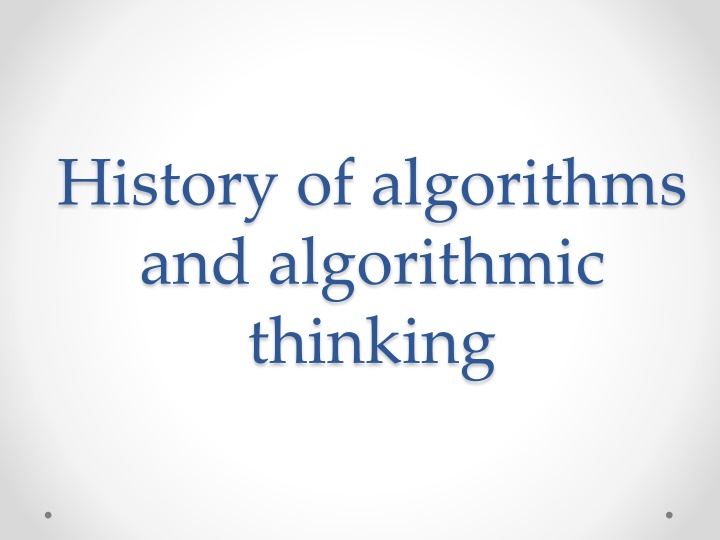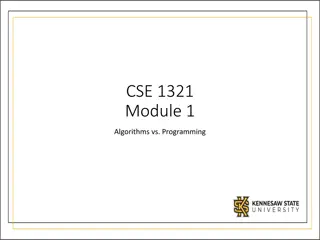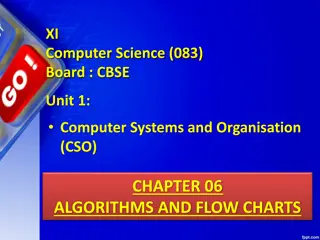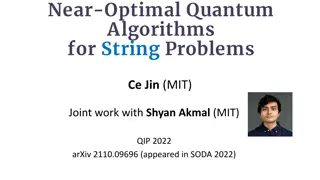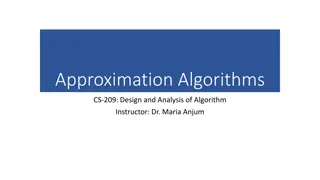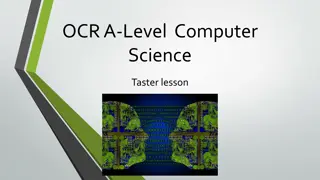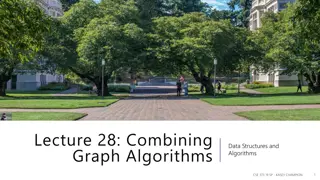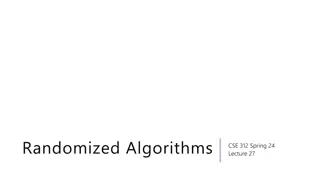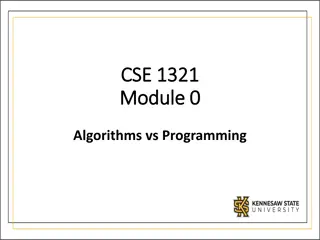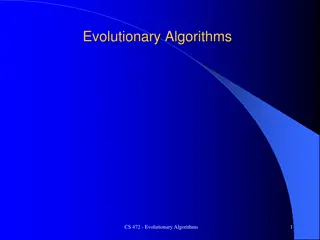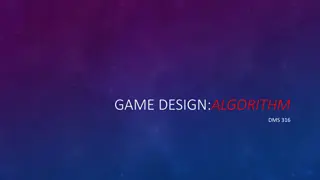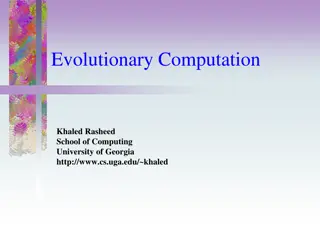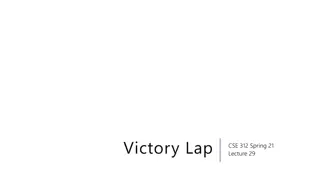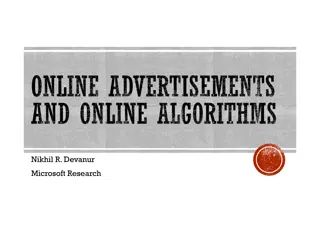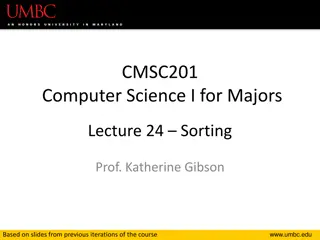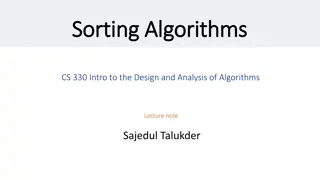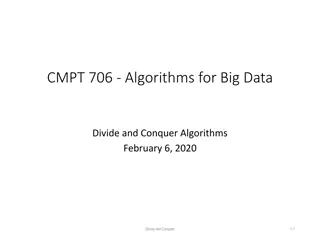Evolution of Algorithms and Computer Science Through History
The history of algorithms and algorithmic thinking dates back to ancient times, with the development of general-purpose computational machines by Charles Babbage in the 19th century marking a significant advancement. The term "computer science" emerged in 1959, encompassing theoretical computer science, computer systems, computer applications, and software engineering. The evolution of hardware and software components, including the invention of algorithms by al-Khwarizmi, has paved the way for modern computer science, emphasizing algorithmic thinking and problem-solving techniques.
Download Presentation

Please find below an Image/Link to download the presentation.
The content on the website is provided AS IS for your information and personal use only. It may not be sold, licensed, or shared on other websites without obtaining consent from the author.If you encounter any issues during the download, it is possible that the publisher has removed the file from their server.
You are allowed to download the files provided on this website for personal or commercial use, subject to the condition that they are used lawfully. All files are the property of their respective owners.
The content on the website is provided AS IS for your information and personal use only. It may not be sold, licensed, or shared on other websites without obtaining consent from the author.
E N D
Presentation Transcript
History of algorithms and algorithmic thinking
The first general-purpose computational machines Differential Engine, Charles Babbage, 1822-1842 Analytical Engine, Charles Babbage, 1837
The first general-purpose computational machines (cont.) Were designed (not quite built) by british Charles Babbage in 1822-1842 and 1837 Were mechanical, general-purpose computers Differential Engine would approximate functions like polynomial, logarithm, trigonometric Analytical engine had also conditional statements, loops
Computer science The term computer science first appeared in an article in Communications of the ACM (Association for Computing Machinery, www.acm.org) in 1959. Computer science is a science that includes: o theoretical computer science : data structures and algorithms, computation theory, information and coding theory, programming languages o computer system: computer architecture and engineering, operating systems, computer networks, databases, concurrent and distributed systems, security o computer applications: artificial intelligence, graphics, audio-video proc. etc. o software engineering Computer science is about hardware and software
History of computer science The official science appeared in 1959 Hardware: computational machines like mechanical calculators appeared first in 1600, but they even existed in rudimentary forms (e.g. abacus) in ancient history, 2700 BC. Software: the term algorithm was first invented by Muhammad ibn Musa al-Khwarizmi, the father of algebra, in a book written in 820 and translated into latin in the 12th century. Algorithm is derived from al- Khwarizmi s name and refers to arithmetic techniques with hindu numerals
History of computer science (cont.) Modern definition of algorithm: sequence of steps necessary in order to solve a specific problem (plus a set of data on which the operational steps operate) Actually, this technique of solving a problem in steps (i.e. algorithmic thinking) can eventually be traced back to ancient history (Euclid s algorithm 300BC, Eratostene s sieve greeks) and even further back in time as part of mathematics
The Babylonian lived in Mesopotamia, a fertile plain between the Tigris and Euphrates rivers (present day Turkey and Syria); dates from around 2000-600BC; replaced the Sumerians and Akkadians Famous for cuneiform writings (wedge-shaped symbols) adopted from the Sumerians Their texts remained on clay tablets Advanced mathematics: extract square and cubic root, work with Pythagorean triples 1200 years before Pythagoras, had a knowledge of pi and possibly e (the exponential function), could solve some quadratics and even polynomials of degree 8, solved linear equations, deal with circular measurement
The Babylonian (2) Babylonian Clay tablet
The Babylonian (3) Sexagesimal (base 60) number system
The Babylonian math Had tables for mathematical operations Division algorithm: a/b= a x (1/b) Reciprocal tables (1/a); 60 is a useful base here because many numbers have finite base 60 fractions, e.g. 1/2, 1/3, 1/4, 1/5, 1/6, 1/10, 1/12, 1/15 and 1/20; although some fractions were infinite (e.g. 1/7, 1/13) Multiplication algorithms: ab = [(a+b)2- a2- b2]/2 ab = [(a+b)2- (a-b)2]/4 Square and cube root approximations: sqrt(a2 + b) approx= a + b/2a
The Babylonian math (cont.) Could solve quadratic equations like ax3 + bx2 = c using tables Had tables for powers of a number Table with Pythagorean triplets:
The Egyptian Had a decimal (base 10) number system; no zero Very good in geometry, not so much in algebra, because they needed to measure areas (e.g. when the Nile would flood the land, they needed to measure it again); measure circles, ratios (pyramids)
The Chinese Math in China was for a long time hidden from other civilisations; a practical approach, not axiomatic Gougu rule = chinese Pithagora theorem Most famous book is Jiuzhang suanshu (Nine Chapters of the Mathematical Art) from around 100AD containing 246 practical problems: o Chapter 1: land surveying, area problems, additions/ substractions/ multiplications/ divisions of fractions, approx. PI o Chapter 2: exchange of goods, proportions o Chapter 3: proportions: direct, inverse, compound, arithmetic and geometric progressions o Chapter 4: areas, unit fractions o Chapter 5: problems on construction of canals, ditches, dykes; volumes o Chapter 6: ratio and proportions; fair distribution of goods o Chapter 7: linear equations solved by making two guesses at the solution, then computing the correct answer from the two errors o Chapter 8: solving systems of linear equations o Chapter 9: right angled triangles, Gougu rule, quadratic equations
The Maya Lived between 250 AD to 900 AD in Yucatan Peninsular (Mexico) People lived in large cities (50.000 people in the city of Tikal) Were conquered by spanish navigators in 1500 and their legacy largely destroyed Had 2 calendars: a ritual calendar of 260 days and civil calendar of 365 days Performed astronomical measurements Did not use multiplications and divisions
Maya number system Had a base 20 number system
The Greeks Thales of Milet Pythagoras Euclid Archimedes Eratosthenes Heron of Alexandria Klaudios Ptolemaeus Diophantos of Alexandria Hypatia
The Greeks From 600BC to 500AD, the greeks made important contributions to mathematics and several other sciences Algorithmic thinking was reflected in greek culture by Euclid s algorithm for greatest common divisor and Eratostene s sieve algorithm for finding prime numbers
Thales of Milet (cont.) Predicted the solar eclipse from May 28, 585 BC Stated Thales theorem Stated that the base angles of an isosceles triangle are equal Believed the Earth was a flat disk floating on an infinite ocean
Pythagoras of Samos (560-480 BC)
Pythagoras (cont.) Founded the mystic Pythagorean cult having the pentagram as symbol Pythagoras was vegetarian but did not eat beans Numbers were mystical for the cult and they believed numbers/proportions govern the matter Developed the theory of Pythagorean numbers (a2 = b2+c2) Proved sqrt(2) is irrational number Believed in reincarnation (even for animals) Fundamental theory in music: dividing the length of a string into ratios of 1/2, 1/3, 1/4, and 1/5 creates the musical intervals of an octave, a perfect fifth, a second octave, and a major third respectively
Euclid (cont.) Lived in Alexandria Wrote the oldest book on rigorous mathematics: Elements Elements began with postulates/axioms (common knowledge) and derived and proved all results from these postulates in a rigorous manner Developed algorithm for finding the greatest common divisor
Eratosthenes (ca. 284-ca. 192 BC)
Eratosthenes Measured the diameter of the Earth Built a star map with 675 stars Sieve of Eratosthenes algorithm for prime numbers
Heron of Alexandria (10 70 AD) Built a steam engine Developed an iterative algorithm/method for computing a square root of a number Developed Heron s formula for the area of a triangle
Archimedes of Syracuse (ca. 287-ca. 212 BC)
Archimedes (cont.) Famous for physics law of Archimedes Contributions in mathematics and physics Various legends about his life: o Shouting Eureka! , running naked on the streets of Syracuse after discovering law of Archimedes o Setting roman ships on fire using large mirrors o Killed by a roman soldier
Klaudios Ptolemaios (85 165 AD) Lived in Alexandria Approximate PI Formulated the geocentric model of the solar system (which lasted until it was negated by Copernicus in 1543 AD).
Diophantos of Alexandria (ca. 201/215 AD ca. 285/299 AD) Also known as the father of algebra Wrote a collection of 13 books called Arithmetica (Pierre de Fermat wrote his last theorem on a side of Diophantus Arithmetica)
The Indian Indian mathematics was influenced by the greeks, egyptians and babylonians, knowledge brought to India by Alexander the Great when he conquered India Around 5 century AD indians moved from a greek number system to a babylonian-like one but in base 10. They invented number zero Because they decoupled numbers from their geometric significance, they also used negative numbers
Aryabhata (476550 AD) Approximated PI Approximated Earth and lunar rotations Affirmed the theory of heliocentrism
Brahmagupa (598-668 AD) Solved 1st degree, 2nd degree and some quadratic degree equations Wrote the first book to treat zero as a number Tried to define division by zero (0/0=0) Stated arithmetic rules for positive and negative numbers and zero
The Arabic The Islam rised by the year 700, occupying Egipt, Syria, Mesopotamia, Persia. Islam advanced on the west until Spain and France and conquered China and India on the east They would absorb the wisdom of the conquered people They took the hindu base 10 numerals from indians and brought it back in Europe.
Abu Abdullah Muhammad bin Musa al-Khwarizmi (780-840 AD)
Abu Abdullah Muhammad bin Musa al-Khwarizmi (cont.) Is considered the father of algebra because he wrote a book Al-jabr w'al-muqabala ; al-jabr becomes algebra and it means to complete a task . He wrote another book about hindu numbers that was translated in the 12 century to latin Algoritmi de numero Indorum ; his name was translated into latin by Algoritmi ; an algorithm would be a trick for working with hindu numbers.
